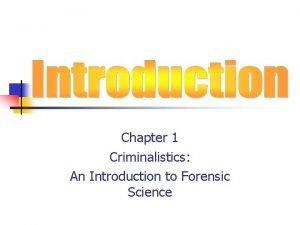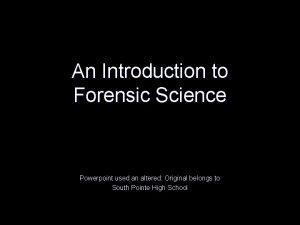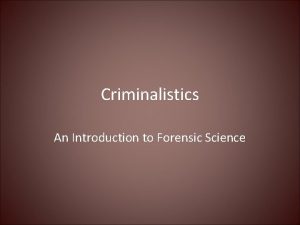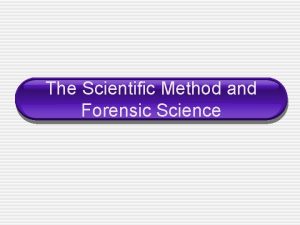Introduction Forensic Science and Criminalistics Scientific Method Empirical








- Slides: 8

Introduction Forensic Science and Criminalistics

Scientific Method • Empirical Evidence: – Knowledge gained from direct observation • Analysis: – Studying an unknown item to determine its characteristics • Comparison: – Determining how the characteristics compare with the properties of known items. • Evaluation – Assessing similarities and differences for identification purposes

• Forensic: – Characteristic of, or suitable for, a court of law. • Forensic Science: – The application of science to the law. • Fields of specialization: – Toxicology, psychology, anthropology, chemistry, odontology, serology, fingerprints, firearms, impressions and tool marks, trace analysis, questioned documents.

Individualization • No two things in nature are exactly the same. – Examples: snowflakes, fingerprints, gun barrels, lip impressions, shoeprints, pieces of broken glass. • Class Characteristics: – Evidence can be associated only with a group and never with a single source • Individual Characteristics: – Evidence can be associated with a common source with a high degree of probability

The Modern Crime Laboratory • Physical Science Unit: – Chemistry, physics, and geology are used in the comparison of crime scene evidence (drugs, glass, paint, explosives, soil) • Biology Unit: – DNA profiling, comparison of hairs and fibers, comparison of wood and plants.

• Firearms Unit: – Examination of firearms, discharged bullets, cartridge cases, shotgun shells, and ammunition of all types. Also includes examination of firearm residues and tool marks. • Document Examination Unit – Analysis of paper, ink, typewriters, handwriting, depressions, erasures, and burned or charred documents.

• Photography Unit: – Examine and Record photographic evidence, including digital imaging, infrared, ultraviolet, and X-ray photography. • Toxicology Unit: – Examination of body fluids and organs for the presence of drugs and poisons. • Latent Fingerprint Unit: – Processing and examination of evidence for latent fingerprints.

• Voiceprint Analysis Unit: – Use of the sound spectrograph to tie a voice (from a telephoned threat or tape-recorded message) to a particular suspect. The instrument transforms a voice into a visual graphic display called a voiceprint. • Evidence Collection Unit: – Specially trained personnel go to the crime scene to collect and preserve physical evidence for later processing at the crime laboratory.















